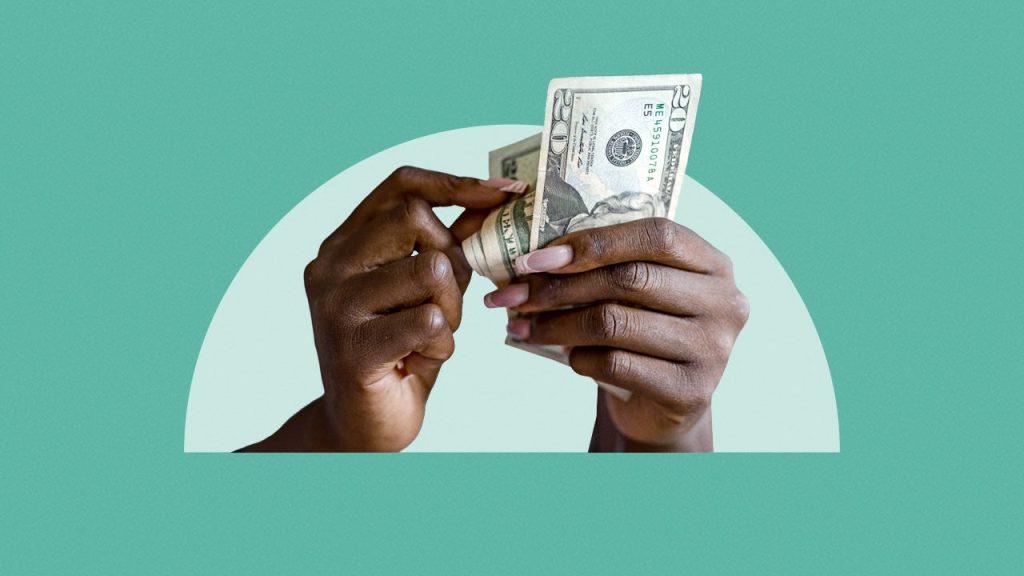Riska/Getty Images; Illustration by Issiah Davis/Bankrate
Small dollar loans are short-term, low-cost installment loans of under $2,500 geared toward borrowers with little to no credit. These loans can help underserved communities get a fair loan since many use nonbank services, which generally come with high rates. They’re highly regulated on federal and state levels so the application process is streamlined, but the requirements may vary depending on the bank.
Compared to traditional lending, small dollar loans are relatively easy to get approved for. Still, you’ll need to research your options, as they’re not as widely available as traditional personal loans.
1. Research your options
Small dollar loans have become more widely available due to their increase in popularity. When looking for this type of loan, consider the following options:
- Select national banks. Six of the eight largest national banks have started offering small dollar loans to consumers within the last five years. As of 2023, Bank of America, Huntington Bank, Regions Bank, Truist, U.S. Bank and Wells Fargo all offer small dollar loans to their customers.
- Community banks or local credit unions. If you’re already a customer or prefer a local lending experience, ask and compare small dollar loan offers from community banks and local credit unions. These institutions tend to be more flexible with their lending criteria than national banks, so it may be easier to secure a small loan dollar from them.
- Community Development Financial Institutions (CDFIs). Some CDFIs participate in the Small Dollar Program, which is a program designed to provide an alternative to expensive options, like payday loans.
Institutions require borrowers to have an account to be eligible for small dollar loans. If you opt for a credit union loan, you’ll need to become a member. The requirements are generally easy to meet and based on factors like location, occupation and association. Some credit unions may also accept donations to a specific nonprofit organization for membership.
That said, it’s always a good idea to start your search with an institution you already have an account with, as the process will be much quicker.
2. Make sure you qualify
Unlike traditional underwriting, which focuses primarily on credit score and history, small dollar loan approval is based on your recent banking activity. Account information like withdrawals, deposits, overdrafts and account status are considered, as well as income and employment history.
While there are general approval requirements for a loan, the Small Dollar Loan Program statutory requirements state that the loans must be “underwritten with standards that consider the consumer’s ability to repay.”
Even though the documentation requests may vary, these are some of the most common requirements borrowers must meet:
- Be at least 18 years old.
- Have a government-issued identification.
- Have an active checking account in your legal name (with a participating bank).
- Provide at least two recent pay stubs.
- Pass an employment verification check.
Even though these loans are designed for borrowers with low credit, it is still possible to get denied based on your recent account history. For example, if you’ve had checks bounce, multiple overdrafts or corresponding accumulated fees over the past few months, you’ll likely have a harder time getting approved.
Additionally, if you don’t have a checking account with a participating bank or credit union, you cannot get a loan immediately upon opening an account. According to Pew’s affordable credit brief, “the major banks that offer small loans all require at least three months of account history before customers can be eligible for these loans, while some smaller banks and credit unions will lend based on as little as one month of account history.”
3. Apply and receive your funds
The applications can be completed online or through the bank’s mobile banking app. If you prefer in-person assistance, call your local branch and ask if there’s customer support available.
Because of the simplified underwriting process, it’s likely that the application will only take a few minutes to complete. To simplify the process, have all the necessary information and documentation on hand.
You should get your application results within one business day (or 24 hours) of submitting your required documentation. Once approved, you’ll sign off on any applicable loan documents, and the funds will be deposited into your account.
When to apply for a small dollar loan
Small dollar loans can be a great alternative to emergency loans, such as payday loans. That’s because they feature significantly lower rates, a more reasonable repayment term and quick funding.
That said, because of their lower limit, they may not be the best alternative for everyone. For instance, small dollar loans could be ideal to pay for an inexpensive car or home repair and some medical expenses.
If you need to borrow money for purposes other than an emergency, then a traditional personal loan may be a better choice. Some lenders — particularly online — offer bad credit loans for those with imperfect credit. Though these loans tend to be more costly than small dollar loans, borrowers have more flexibility with their use. These loans also feature much higher amounts and longer repayment terms than small dollar loans.
Before applying, weigh the pros and cons of each option to ensure you’re choosing the best one for your situation.
Frequently asked questions
-
According to the Community Development Financial Institutions Fund, a small dollar loan is any that:
- Does not exceed $2,500.
- Is repaid in installments.
- Has payments reported to the credit bureaus.
- Doesn’t have a prepayment penalty.
-
The fastest way to get a small dollar loan is through your current bank or credit union. You won’t need to go through the process of opening a new account, and if yours is in good standing it’ll make the process even faster.
-
Banks and credit unions that participate in the Small Dollar Program have online and mobile portals that allow its pre-existing customers to apply for a small dollar loan virtually.
-
Small dollar loans don’t require a credit score for approval like most traditional loans. However, this doesn’t mean that everyone will be approved. Eligibility is largely based on your routine bank account information and activity. All things considered, small dollar loans may be easier to get approved for compared to personal loans as long as your bank account is in good standing.
Read the full article here










